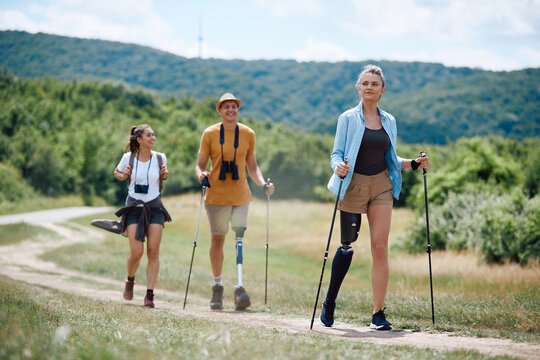Essential Tips for Exploring the World with Limb Loss and Limb Differences
As the sun shines brighter and the temperature rises, summer beckons us to embark on exciting adventures and explore new horizons. For prosthetic users, the season brings a unique set of considerations and opportunities when it comes to travel. Whether you're planning a beach getaway, a hiking expedition, or simply longing for a refreshing dip in the pool, we're here to ensure that your summer travels are as enjoyable and hassle-free as possible.
For a prosthetic user, it is crucial to feel confident, comfortable, and well-prepared while engaging in various activities and embracing the season's spirit. In this blog post, we'll be sharing essential tips, insights, and recommendations specifically for them venturing out during the summer months.
From travelling by plane and choosing the right prosthetic for water activities to managing sweat and moisture, from sun protection for your residual limb to navigating sandy or uneven terrains, there is a range of topics to help you make the most of your summer adventures. Our aim is to empower you to embrace the joys of summer travel, seize new experiences, and create lasting memories with the utmost ease and confidence. Use this blog post to create your holiday checklist and prepare for your next adventure!
Before we start, don’t forget that you must consult with your rehabilitation team to ensure that everything is well with you and your prosthetic device and that you can travel safely and without any problems in sight.
In a previous publication, we discussed some techniques for managing sweat and caring for your residual limb during the summer season. Now, let's shift our attention to valuable tips specifically tailored for prosthetic users embarking on air travel.
Before the flight
In this section, we will cover important topics to address prior to embarking on a flight journey. First things first, let’s pack! Here, we have compiled a list of must-have items for prosthetic users, ensuring you are well-prepared for your trip:
Keep in mind that unforeseen things can happen with your prosthetic components, and therefore there may need to be some replacement. Consider taking with you extra sock-ply, liners, sleeves, chargers, or straps, depending on your needs.
It can be beneficial to carry a small tool kit to tighten specific parts of your prosthesis in case of an emergency. However, it is crucial to note that it is the responsibility of your prosthetist to make any necessary adjustments to your prosthesis. That's why it is essential to visit them before travelling to ensure that everything is properly in place and functioning correctly. Your prosthetist is the expert who can provide the appropriate adjustments and ensure the optimal performance of your prosthesis.
Ensure that you pack essential skin care products, including antibacterial soap, to maintain proper care for your residual limb during your travels. Consider the climate at your destination and consult with your specialist (a healthcare provider or prosthetist) to determine if an antiperspirant is necessary for your trip.
Take with you the necessary documentation related to your prosthetic devices in case you need to show it at security checkpoints or if you need some medical assistance.
In the same vein, confirm that you take with you any prescription medications related to your prosthetic use that might be necessary.
Additionally, remember to pack any medications that are vital for your well-being, such as those related to conditions like diabetes that may be associated with your amputation.
Remember that there is always the chance of hold bags getting lost and taking some time to reach your final destination, so we advise you to put the essential items in your handbag.
To feel more secure, consider purchasing travel insurance; if so, don’t forget to always keep a copy of this information. Try to make a list of hospitals or health professionals that can help you where you are going, just in case.
If you’re travelling in the USA, you can contact Transportation Security Administration (TSA) Cares, a helpline created to assist travellers with disabilities, medical conditions, and other specific circumstances during the security screening process. For more information and additional resources, you can visit the following links: TSA Passenger Support and Amputee Coalition TSA Security Checkpoint. These resources will provide you with valuable insights and guidance to ensure a smoother travel experience.
During the flight
If you get a chance, choose one of the seats with the most room in advance so that you can get into the most comfortable position for you during the flight. Additionally, wearing comfortable clothing will further enhance your overall comfort level throughout the flight. Consider opting for loose-fitting and breathable attire to make your travel experience even more enjoyable.
If you are using your prosthesis during the flight, we recommend you not remove your socket, as you may run the risk of not being able to put it back on immediately due to possible volume changes in your residual limb. If you really need to remove it, keep it within reach, and use pillows or blankets to support the residual limb if needed. This way, you can minimize any potential discomfort or difficulties when donning your prosthesis again. Consider taking crutches in case you want to remove the prosthesis during a long flight or if you are unable to do it again. If you need or prefer to take a wheelchair with you, we advise you to contact the airline in advance to confirm their procedures for accommodating your mobility device. Flight attendants will assist you in reaching your seat and will handle stowing the wheelchair for you. Alternatively, you have the option to check your wheelchair or walker as baggage.
To improve blood circulation, reduce swelling, and provide added support during prolonged periods of sitting, we recommend wearing a compression sock or liner on your residual limb. However, it's important to consult with your healthcare provider or prosthetist for personalized advice. They can assess your specific situation and provide recommendations based on your individual needs and medical history. They may suggest a specific type or level of compression that would be most beneficial for you during air travel. It is also essential to take frequent breaks to move around, stretch, and execute simple exercises. Trying to move and stretch will contribute to your well-being and enhance your overall comfort throughout the flight.
Remember that every prosthetic user has their specific needs, and you should always adapt these tips to whatever makes sense for you. Back to the first tip and advice in this blog post: don't forget to consult your healthcare provider or prosthetist before you travel. They possess the expertise to provide tailored guidance based on your specific medical case and prosthetic requirements. By seeking their professional advice, you can ensure that you receive the most appropriate recommendations for a safe and enjoyable travel experience. Remember to prioritize your well-being and fully enjoy your vacation!




